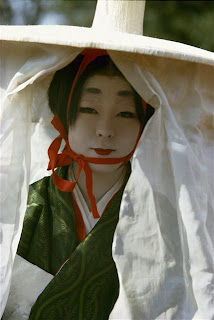Monday, October 24, 2011
JIDAI MATSURI-FESTIVAL OF AGES FROM JAPAN!!
The Jidai Matsuri Festival of the Ages is a traditional Japanese festival (also called the matsuri) held on October 22 annually in Kyoto, Japan. It is one of Kyoto's renowned three great festivals, with the other two being the Aoi Matsuri, held annually on May 15, and the Gion Matsuri, which is held annually from 17 to July 24. It is a festival enjoyed by people of all ages, participating in its historical reenactment parade dressed in authentic costumes representing various periods, and characters in Japanese feudal history.
Jidai Matsuri traces its roots with the relocation of the Japanese capital to Tokyo in 1868. This involved the relocation of the Emperor of Japan and his imperial family, the Imperial Palace and thousands of government officials and subjects to the city. Fearing for Kyoto's loss in glory and interest by her people, the city government and the Kyoto Prefectural Government commemorated the 1100th anniversary of the founding of Heian-kyō which was the former name of Kyoto, in 794 by Emperor Kammu (737 - 806). To inaugurate the first Jidai celebration in 1895, the city government built the
Heian Shrine to enshrine the spirit of Emperor Kanmu. To add meaning to the festival, it staged a costume procession representing people of each era in Kyoto history. In 1940, the local government decided that on top of honouring Emperor Kammu, the Jidai festival was also to be held in honour of Emperor Kōmei (July 22, 1831 - January 30, 1867) for his work in unifying the country, the power of the imperial court and the affirmation of Kyoto as the center of Japan at the decline of the Tokugawa Shogunate and the Edo Era.
The Jidai Matsuri begins in early morning with the mikoshi (portable shrines) brought out of the Old Imperial Palace so that people may pay their respects. The mikoshi represent emperors Kanmu and Kōmei, respectively. The five-hour, two-kilometer costume procession begins in the afternoon, with approximately 2,000 performers dressed as samurai, military figures, and common people, from the earliest eras to the Meiji era These are followed by Japanese women who are dressed in elaborate jūnihitoe. And, finally, the mikoshi are carried from the palace and are accompanied by a costumed military band that is playing the gagaku. The procession ends at the Heian Shrine.
Subscribe to:
Post Comments (Atom)










No comments:
Post a Comment